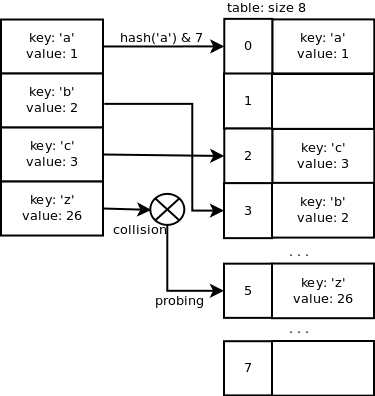C Program To Implement Dictionary Using Hashing Techniques
What is the easiest way to encrypt a password when I save it to the registry Please also consider salting your hash not a culinary concept. Basically, that means appending some random text to the password before you hash it. The salt value helps to slow an attacker perform a dictionary attack should your credential store be compromised, giving you additional time to detect and react to the compromise. To store password hashes a Generate a random salt value byte salt new byte3. System. Security. Cryptography. RNGCrypto. Service. Provider. Create. Get. Bytessalt. Append the salt to the password. Convert the plain string pwd into bytes. Hashing+as+a+Dictionary+Implementation.jpg' alt='C Program To Implement Dictionary Using Hashing Techniques' title='C Program To Implement Dictionary Using Hashing Techniques' />
1. A domain is if elements of the domain are considered to be indivisible units. Atomic b Subatomic c Substructure d Subset View Answer. Sanfoundry is No. Deep HandsON Trainings in SAN, Linux C, Kernel Programming. Our Founder has trained employees of almost all Top Companies in India. The General Hash Function Algorithm library contains implementations for a series of commonly used additive and rotative string hashing algorithm in the Object Pascal. 3D Live Pool Full Crack. Hyperlinked definitions and discussions of many terms in cryptography, mathematics, statistics, electronics, patents, logic, and argumentation used in cipher. UploadFile/746765/dictionary-implementation/Images/code.jpg' alt='C Program To Implement Dictionary Using Hashing Techniques' title='C Program To Implement Dictionary Using Hashing Techniques' />Text. Bytes System. Text Unicode. Encoding. Unicode. Get. Bytesplain. Text. Append salt to pwd before hashing. Bytes new byteplain. Text. Bytes. Length salt. Length. System. Buffer. Block. Copyplain. Text. Bytes, 0, combined. Bytes, 0, plain. Text. Bytes. Length. System. Buffer. Block. Copysalt, 0, combined. Bytes, plain. Text. Bytes. Length, salt. Length. c Hash the combined password salt Create hash for the pwdsalt. System. Security. Cryptography. Hash. Algorithm hash. Algo new System. Security. Cryptography. SHA2. 56. Managed. Algo. Compute. Hashcombined. Bytes. d Append the salt to the resultant hash. Append the salt to the hash. Plus. Salt new bytehash. Length salt. Length. System. Buffer. Block. Copyhash, 0, hash. Plus. Salt, 0, hash. Length. System. Buffer. Block. Copysalt, 0, hash. Plus. Salt, hash. Length, salt. Length. Store the result in your user store database. This approach means you dont need to store the salt separately and then recompute the hash using the salt value and the plaintext password value obtained from the user. Edit As raw computing power becomes cheaper and faster, the value of hashing or salting hashes has declined. Jeff Atwood has an excellent 2. This using salted hashes will provide the illusion of security more than any actual security. Since you need both the salt and the choice of hash algorithm to generate the hash, and to check the hash, its unlikely an attacker would have one but not the other. If youve been compromised to the point that an attacker has your password database, its reasonable to assume they either have or can get your secret, hidden salt. The first rule of security is to always assume and plan for the worst. Should you use a salt, ideally a random salt for each user Sure, its. But these days. salts alone can no longer save you from a person willing to spend a.